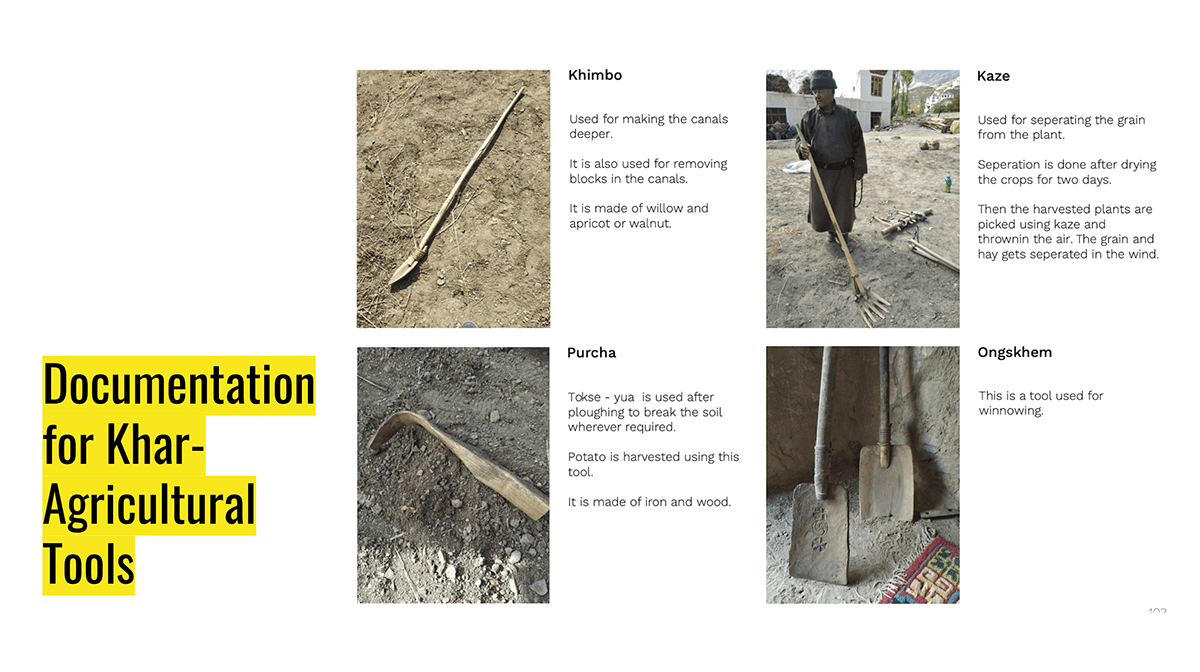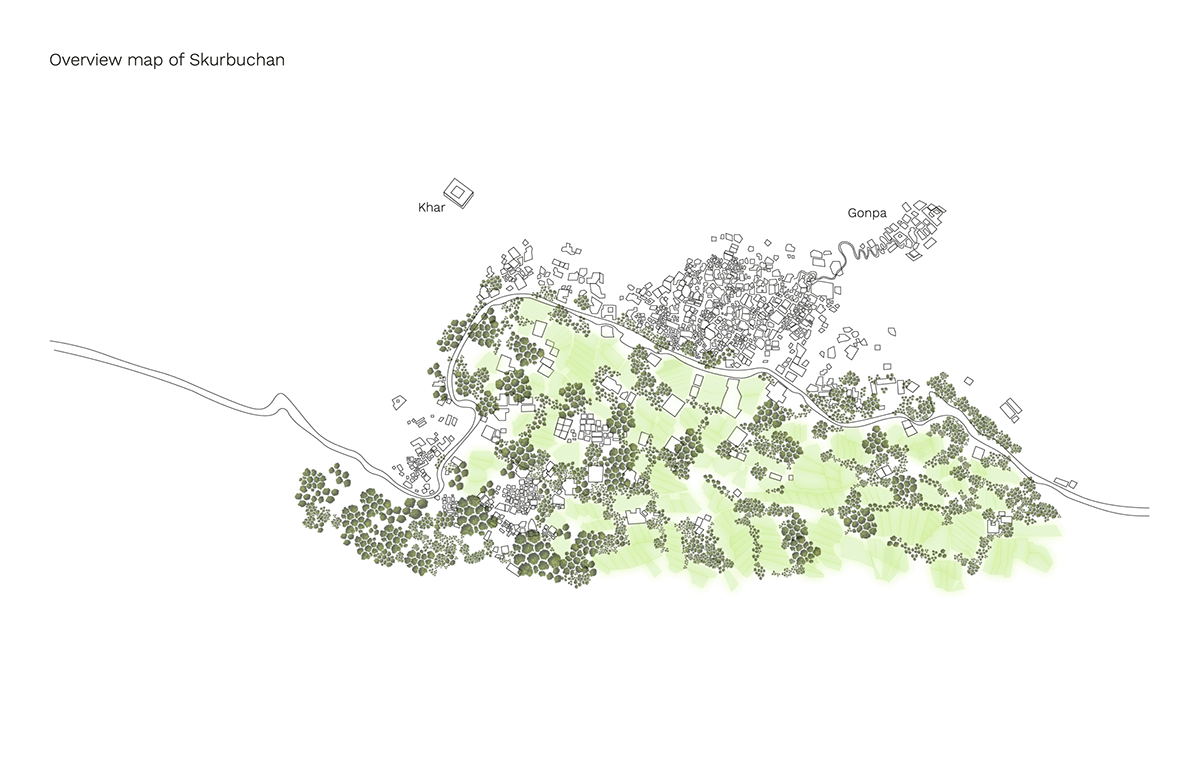Overview of the project
Supported by the Cultural Preservation Grant of the Federal Republic of Germany in India, and in collaboration with Achi Association, this design project was undertaken to prepare the grounds for setting up two museums in the remote village of Skurbuchan in Khaltse District, Ladakh for carrying out the vision of head monk of the Skurbuchan Gonpa ( Buddhist monastery) - to propose ways of developing sustainable communities (SDG 11) through the medium of museums.
Scope of Work
This project was pitched to the team as a long-term project ( 5-7 years ) by Achi Association, hence on arrival to the village it seemed imperative to research and document the village's agricultural practices and craftsmen, in an attempt to make an archive of the rapidly losing tangible and intangible heritage, so that the teams sent out in the following years had records to refer to and enough information and documentation of the village to build their work on.
The outcome of this research directly helped in fulfilling the bigger brief as Museum Designers – to conceptualise, masterplan, and set the foundation for two museums (Kitchen Museum in Gonpa & Agro Museum in Khar) that would be set up in the village. Part of our role also involved in making locals understand what a museum is, what role does it/ can it play in the community, and how they could be a part of its development.

----
The development of the Skurbuchan Kitchen Museum and Agro Museum was a heavily research-driven project. Due to a small team, and the leaving of team members during the field work duration due to health problems caused by high altitude and extreme weather conditions of the region coupled with lack of adequate facilities in the village, my scope of work increased so as to be able to deliver to our clients and meet the deadlines within the stipulated duration.
My work focused on community engagement, information collection, research and curation of object artefacts for both museums, documentation of tangible and intangible heritage as a Field Researcher, Curator, Information Mapping, and Museum Designer (layout, zoning, masterplan with proposals) .

Introduction to the village
Skurbuchan is a remote village located in the Khaltse district, in the sham region, Ladakh. It is a small village populated by around 300 households.Skurbuchan, also known as Skyur Buchan, has an established Buddisht monastery, of the Drigung sect, following the school of Kagyudpa lineage. On the Western cliff, overlooking the entire village, is the Khar, a small palace that served as a temporary residence for the kings. While on the East, enveloped by the steep cliffside slope, the Monastery (Gonpa) stands, at the highest point, overlooking the village of Skurbuchan.



Illustrations(from L to R): Skurbuchan location in Ladakh, Map of Skurbuchan, Neighbourhood segregation (Phaspons) within Skurbuchan.
My vision for the project as a Museum Designer
My area of interest for this project was to figure out a way of creating sustainable livelihoods for the local community through research.
My area of interest for this project was to figure out a way of creating sustainable livelihoods for the local community through research.
• What are the ways in which we can develop a mutually beneficial system of coexistence between the museum as an institution and the community members?
• How can I incentivise rural communities to stay put in their home village and pass down their way of life to the younger generations through the museum (to tackle migration problems)?
• Can the museum space represent something more than a spot for tourism and student school visits? A space that acts as a bridge for knowledge exchange between different generations and between locals and outsiders.
Information Collection and Research Mapping
Objective
• Mapping the flow of agro-product goods, and craft goods in and out of the village.
• Document the craftsmen, the skillset and crafts of the village, and the agricultural produce that is their main source of income.
• Identify their (farmers and craftsmen) main market, and consequent dependence/relationship between different settlements in the region.
• Identify their (farmers and craftsmen) main market, and consequent dependence/relationship between different settlements in the region.


Interviews and Workshops
All the craftsmen of the village were interviewed, and their crafts were documented in a detailed research report, in an attempt to archive the remains of their dying tangible heritage with most of them being the only living individual with the skills and knowledge of their respective crafts in the region.


(above) Interviews taken by Urja Jhaveri, recorded and documented in film by Shruti Chakke
Snippets of video documentation of agro-processes filmed to facilitate research in the field. Video Shot by Urja Jhaveri.
[In video]: Village woman roasting the grains in grey soil as part of the process of making snacks out of barley grains, a tradition of community cooking to prepare for winters
One of the core project challenges was to convey the idea of a 'museum' to villagers that were unaware of the existence of such an institution. We bore the responsibility to not only develop the space in the context, but also given the task of establishing the relevance of the museums to the residents, and convince younger and older generations to come together to contribute to the making, maintenance and the existing artefact collection of both the museums.



Photographs from the Museum Design Workshop held for local school students
We thus hosted a Museum Design Workshop with the Higher Secondary School students to understand their expectations from the space, and demo the crucial elements of a museum with activities like - label making for the artefacts, masterplanning, and design exhibit cases for the artefacts.
The team also hosted a workshop for the elderly, for collecting information on older traditions and practices lost with upgrade of technology, make them understand the need for a space that can carry out discourse on food, culture, local lifestyle practices, and persuade them to donate their heirloom utensils that have been passed down since generations to enrich the artefact collection of the museum.


Photographs from the Museum Development Workshop for adults
The Kitchen Museum, in Skurbuchan Gonpa, needed to be developed till the stage of a decided narrative, content layout, display ideas and visualisations. While for the spaces in Khar, Agro Museum – documentation of agro-pastoral practices was required, to develop an interpretive plan for the Agriculture Museum.
KITCHEN COMMUNITY MUSEUM
Narrative Note
Narrative Note
People of Ladakh made their living through Agro-pastoral practices. Their resilience and creativity can be seen through their ability to survive and thrive in the harsh climatic conditions of the region and work within limited resources.
The Museum takes the visitors through the journey of Ladakhi lifestyle and food practices which has shaped their way of living.




Above: (L)Plan of the Museum Space, drafted on field (R) Content Layout in the space

Above: Excerpts from the visualisations of proposed interventions and ideas to be incorporated in the Kitchen Community Museum
Visualisations by Kunal Lokhande

Picture layout: Kitchen Community Museum zoning and layout.
Zoning and Layout by Urja Jhaveri and Guide, Illustrated by Aijin Shaji.
BOOKLETS
Proposed Idea of booklets that prompt and actively engage visitors in artefact recognition, understanding, and inviting them to draw connections between older forms/ substitutes of vessels that are found in modern kitchens as one of the means of information delivery in the Museum space other than labels and panels.



Booklet mockups by: Kunal Lokhande (For conceptual representation use only)
AGRO MUSEUM
Since the traditional tools used on the farms are already disappearing, the team had to catalogue the tools used in cultivation of their land in Skurbuchan to not only study the items that will eventually be housed in the museum, but also make a document of these artefacts for Achi Association. In kitchen museum, we already had a catalogue that had been worked upon by local girls (commissioned a few years ago); before setting the Agro Museum in Skurbuchan Khar, we needed to make a similar document for the objects that would be housed within.




Documentation on field carried out by Aijin Shaji
Approach to the Interpretive Plan Proposal
Room segregation based on seasons; and setups within those rooms would display the objects used in the activities that are performed during that season – for example, winter season room would house objects related to spinning of the yak wool and related craft products. The end space (Part C.) – Kitchen space– is proposed as space that links the Khar Agro Museum to the Kitchen Museum in Gonpa. Linking the activities Behind the scenes to cultivate food (Khar) , that are brought into the Kitchen to prepare local food recipes (Gonpa). [ Farm to table full circle concept ]


Zoning and Layout Proposed for Agro Museum in Khar
(beyond scope of work)

(above) Zoning and Layout by Aijin, Kunal and Urja. Visuals by Aijin Shaji
My Role in the Project
Field Researcher • Authored a report on the agricultural practices of the village, and craft process of a collapsible Namboo loom.
Curator Curated the existing artefact collection of the Kitchen Community Museum.
Information Mapping • Mapping the flow of goods in and out of the village: To map the connections of the village to its surrounding settlements and analyse how self-sufficient/ dependent Skurbuchan is.• Mapping the crafts: Draw linkage between the agro-pastoral practices and the subsequent crafts in the village, and also bring to light how preservation of intangible and tangible heritage is directly linked to the present craftsmen and their skills.
Museum Designer • Developing the narrative episodes, layouts and zoning for the Kitchen Community Museum based on field research and workshops conducted. Assisting in development of Interpretive Plans for the Agro Museum. • Developed a Sustainable Tourism Plan, that could be implemented in the village, and a programmes list for museum.

Picture above: Team and Support at Gonpa
View full Project document on: Issuu
Project Duration: 12 weeks
Team: Urja Jhaveri , Shruti Chakke, Aijin Shaji, Kunal Lokhande
Project Facilitators: Tanishka Kachru, Jonak Das
Research and Illustrations: Urja Jhaveri
Documentation of Agricultural Tools: Aijin Shaji
Craft Documentation and Interviews: Shruti Chakke and Urja Jhaveri
Video Compilation: Shruti Chakke
In Space Visualizations and Concept mockups 2.5D: Kunal Lokhande and Aijin Shaji
2019

Illustration by Urja Jhaveri








